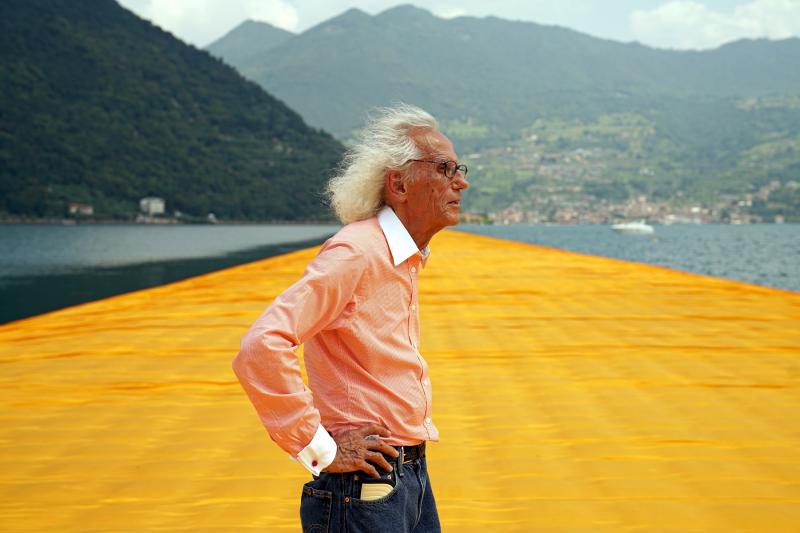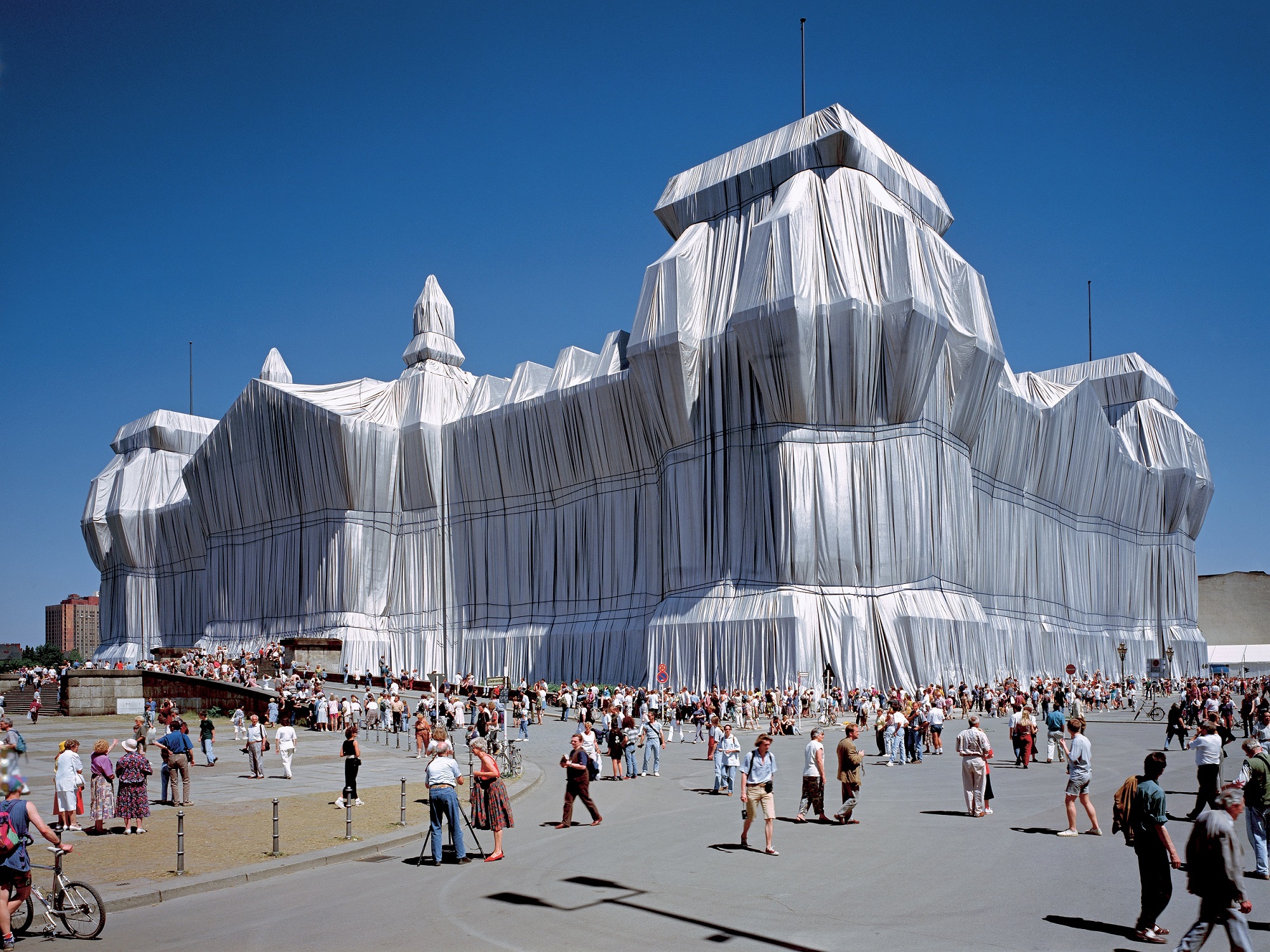Christo (1935-2020) - 'Beauty, science and art will always triumph' | reviews, news & interviews
Christo (1935-2020) - 'Beauty, science and art will always triumph'
Christo (1935-2020) - 'Beauty, science and art will always triumph'
One of the great visionaries of our era, Christo believed absolutely in art for art's sake

The death of Christo, aged 84, was announced on Sunday, marking the end of a visionary and flamboyant artistic career.
Christo was born Christo Vladimirov Javacheff in communist Bulgaria in 1935, attending art school in Sofia before escaping to the west by bribing a customs officer when he was 21. Via Prague, Vienna and Geneva he arrived in Paris in 1958 where he met his lifelong partner Jeanne-Claude; their marriage a year later was followed in 1960 by the birth of their son, Cyril. Together, they would conceive and realise projects that transformed notions of sculpture and public art forever, Christo continuing alone after Jeanne-Claude’s death in 2009.
Early works anticipated the large scale wrapping of landscapes and buildings that would become their trademark, and in the 1950s Christo experimented with smaller objects like telephones and motorbikes, statues and women. The process of swathing objects in fabric and other materials developed ideas that had preoccupied generations of sculptors from the ancient Greeks to Henry Moore, whose famous shelter drawings, made during the Blitz in 1941, are an extended study of the clothed human figure.
 For Christo, wrapping an object facilitated what the art critic David Bourdon neatly summed up as "revelation through concealment”, emphasising certain physical characteristics, but also introducing mystery and vulnerability, as seen in the billowing contours of the Wrapped Reichstag (pictured above), the building’s heavy, neo-baroque proportions transformed into a fairytale palace. Art’s power to bridge the gap between reality and imagination has always been uppermost in the work of Christo and Jeanne-Claude, with yellow fabric unfurled across an Italian lake to allow people to walk on water (main picture), the islands in Biscayne Bay, Florida, surrounded with bubble-gum pink fabric, to become giant confections. If Christo and Jeanne-Claude made landscape their studio, they were always aware that it was never their plaything, however whimsical the project. In 1991, high winds made the umbrellas installed in a Japanese valley unsafe, killing a person and injuring others. Valley Curtain, installed between two Colorado mountains in 1972 lasted just 28 hours before a gale forced its removal.
For Christo, wrapping an object facilitated what the art critic David Bourdon neatly summed up as "revelation through concealment”, emphasising certain physical characteristics, but also introducing mystery and vulnerability, as seen in the billowing contours of the Wrapped Reichstag (pictured above), the building’s heavy, neo-baroque proportions transformed into a fairytale palace. Art’s power to bridge the gap between reality and imagination has always been uppermost in the work of Christo and Jeanne-Claude, with yellow fabric unfurled across an Italian lake to allow people to walk on water (main picture), the islands in Biscayne Bay, Florida, surrounded with bubble-gum pink fabric, to become giant confections. If Christo and Jeanne-Claude made landscape their studio, they were always aware that it was never their plaything, however whimsical the project. In 1991, high winds made the umbrellas installed in a Japanese valley unsafe, killing a person and injuring others. Valley Curtain, installed between two Colorado mountains in 1972 lasted just 28 hours before a gale forced its removal.
The first large scale wrapping project, Stacked Oil Barrels and Dockside Packages, Cologne Harbor, 1961, made from rolls of paper, oil barrels, tarpaulin and rope was also the first collaboration between Christo and Jeanne-Claude, and Jeanne-Claude’s indefatiguability would prove essential to the success of the couple’s increasingly ambitious projects, many of which, like Valley Curtain, were hampered by local opposition and bureaucracy. Diplomacy and logistics were Jeanne-Claude’s domain, about which she was never less than frank, explaining in an interview included in Antonio Ferrera’s 2010 film, Nomad of Art, that she had become an artist out of love for Christo: “I didn’t know anything about contemporary art”, she said “even less about avant-garde art. I was just in love with a young man who was in love with me.”
 Though Christo was always responsible for the design of the project, producing quantities of endlessly detailed drawings, the years or even decades of planning and preparation involved in a single project made logistics as much a part of the art work as the inevitably brief, if triumphant, end result. The Wrapped Reichstag took more than 20 years, and so though Jeanne-Claude died in 2009, works realised long after her death continue to be credited to her (pictured above: Christo and Jeanne-Claude, 2005). Their joint commitment to their art was such that they always took separate flights, so that if one of them should die, the other could continue their work. Even so, it would take until 1994 for Jeanne-Claude’s equal role in the collaboration to be fully acknowledged, at the insistence of Christo.
Though Christo was always responsible for the design of the project, producing quantities of endlessly detailed drawings, the years or even decades of planning and preparation involved in a single project made logistics as much a part of the art work as the inevitably brief, if triumphant, end result. The Wrapped Reichstag took more than 20 years, and so though Jeanne-Claude died in 2009, works realised long after her death continue to be credited to her (pictured above: Christo and Jeanne-Claude, 2005). Their joint commitment to their art was such that they always took separate flights, so that if one of them should die, the other could continue their work. Even so, it would take until 1994 for Jeanne-Claude’s equal role in the collaboration to be fully acknowledged, at the insistence of Christo.
The London Mastaba (pictured below), unveiled on the Serpentine in Hyde Park in June 2018, to coincide with a major retrospective exhibition at the Serpentine Galleries, was the pair’s first large scale project in London, and the partial fulfillment of a project that began as far back as the 1960s. Created from stacked oil drums, the massive floating structure took the form of a mastaba, a truncated trapezoid, and the Arabic word for bench. Massive as it was, the structure was a fraction of the size of the Abu Dhabi mastaba that has been in development since 1977, and which at 150m high and built from 410,000 steel barrels, was destined to be the largest permanent sculpture in the world.
Like fabric, oil barrels featured in Christo’s work as far back as the 1950s, when they were readily available in a yard next to his studio. Easy to stack, dismantle and rearrange, barrels proved an ideal material, and featured in Iron Curtain, a barricade installed across a Paris street in 1962, as a protest against the Berlin Wall that had been built the previous year.
 Though this seemed like an overtly political gesture, Christo and Jeanne-Claude have always denied any such significance in their work, refusing sponsorship of any kind and funding projects themselves in order to maintain artistic freedom. Similarly, they insisted that a work, once removed, must leave no trace on the landscape, with all materials being reused or recycled, and no long-term change made to the environment.
Though this seemed like an overtly political gesture, Christo and Jeanne-Claude have always denied any such significance in their work, refusing sponsorship of any kind and funding projects themselves in order to maintain artistic freedom. Similarly, they insisted that a work, once removed, must leave no trace on the landscape, with all materials being reused or recycled, and no long-term change made to the environment.
A statement issued on Sunday by the artists’ office confirmed that Christo died at home in New York City from natural causes, and concluded: “In a 1958 letter Christo wrote, 'Beauty, science and art will always triumph.' We hold those words closely today.”
A project to wrap the Arc de Triomphe in Paris is planned to go ahead, to be completed in September 2021 in accordance with the artists’ wishes, and later this year, an exhibition will open at the Centre Georges Pompidou about Christo and Jeanne-Claude's work and time in Paris.
Explore topics
Share this article
The future of Arts Journalism
You can stop theartsdesk.com closing!
We urgently need financing to survive. Our fundraising drive has thus far raised £49,000 but we need to reach £100,000 or we will be forced to close. Please contribute here: https://gofund.me/c3f6033d
And if you can forward this information to anyone who might assist, we’d be grateful.

Subscribe to theartsdesk.com
Thank you for continuing to read our work on theartsdesk.com. For unlimited access to every article in its entirety, including our archive of more than 15,000 pieces, we're asking for £5 per month or £40 per year. We feel it's a very good deal, and hope you do too.
To take a subscription now simply click here.
And if you're looking for that extra gift for a friend or family member, why not treat them to a theartsdesk.com gift subscription?
more Visual arts
 'We are bowled over!' Thank you for your messages of love and support
Much-appreciated words of commendation from readers and the cultural community
'We are bowled over!' Thank you for your messages of love and support
Much-appreciated words of commendation from readers and the cultural community
 Lee Miller, Tate Britain review - an extraordinary career that remains an enigma
Fashion photographer, artist or war reporter; will the real Lee Miller please step forward?
Lee Miller, Tate Britain review - an extraordinary career that remains an enigma
Fashion photographer, artist or war reporter; will the real Lee Miller please step forward?
 Kerry James Marshall: The Histories, Royal Academy review - a triumphant celebration of blackness
Room after room of glorious paintings
Kerry James Marshall: The Histories, Royal Academy review - a triumphant celebration of blackness
Room after room of glorious paintings
 Folkestone Triennial 2025 - landscape, seascape, art lovers' escape
Locally rooted festival brings home many but not all global concerns
Folkestone Triennial 2025 - landscape, seascape, art lovers' escape
Locally rooted festival brings home many but not all global concerns
 Sir Brian Clarke (1953-2025) - a personal tribute
Remembering an artist with a gift for the transcendent
Sir Brian Clarke (1953-2025) - a personal tribute
Remembering an artist with a gift for the transcendent
 Emily Kam Kngwarray, Tate Modern review - glimpses of another world
Pictures that are an affirmation of belonging
Emily Kam Kngwarray, Tate Modern review - glimpses of another world
Pictures that are an affirmation of belonging
 Kiefer / Van Gogh, Royal Academy review - a pairing of opposites
Small scale intensity meets large scale melodrama
Kiefer / Van Gogh, Royal Academy review - a pairing of opposites
Small scale intensity meets large scale melodrama
 Jenny Saville: The Anatomy of Painting, National Portrait Gallery review - a protégé losing her way
A brilliant painter in search of a worthwhile subject
Jenny Saville: The Anatomy of Painting, National Portrait Gallery review - a protégé losing her way
A brilliant painter in search of a worthwhile subject
 Abstract Erotic, Courtauld Gallery review - sculpture that is sensuous, funny and subversive
Testing the boundaries of good taste, and winning
Abstract Erotic, Courtauld Gallery review - sculpture that is sensuous, funny and subversive
Testing the boundaries of good taste, and winning
 Edward Burra, Tate Britain review - watercolour made mainstream
Social satire with a nasty bite
Edward Burra, Tate Britain review - watercolour made mainstream
Social satire with a nasty bite
 Ithell Colquhoun, Tate Britain review - revelations of a weird and wonderful world
Emanations from the unconscious
Ithell Colquhoun, Tate Britain review - revelations of a weird and wonderful world
Emanations from the unconscious
 Rachel Jones: Gated Canyons, Dulwich Picture Gallery review - teeth with a real bite
Mouths have never looked so good
Rachel Jones: Gated Canyons, Dulwich Picture Gallery review - teeth with a real bite
Mouths have never looked so good

Add comment